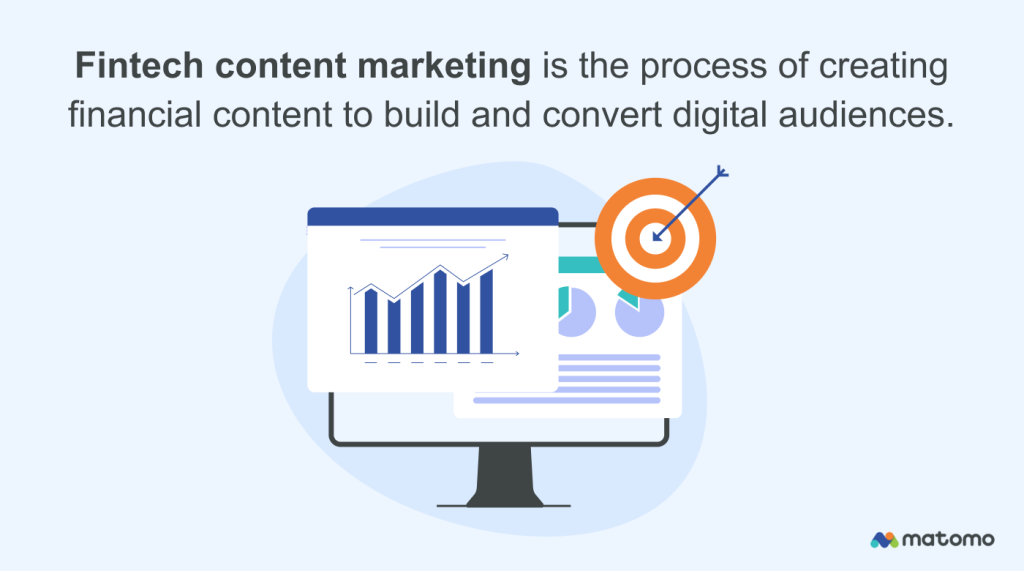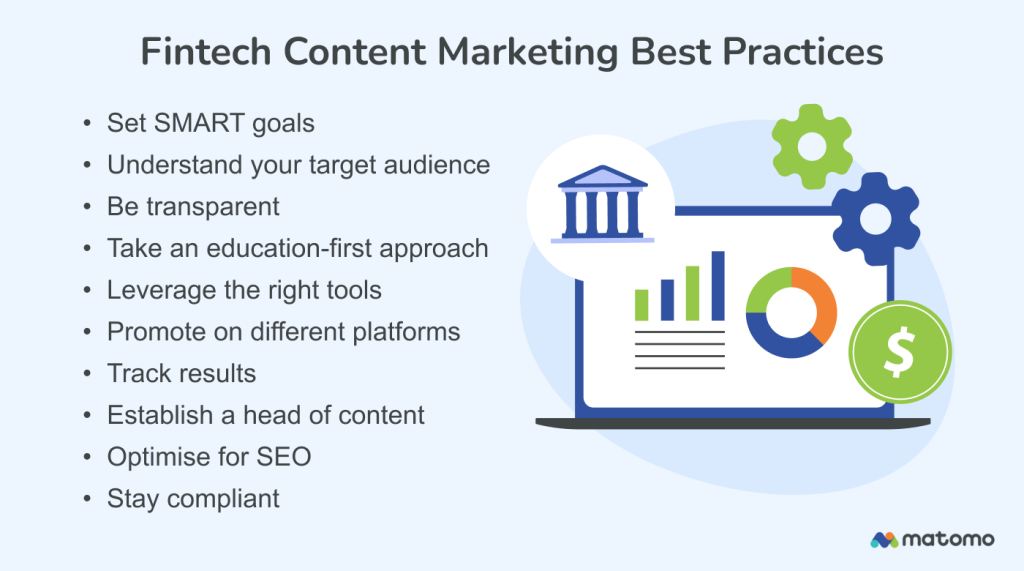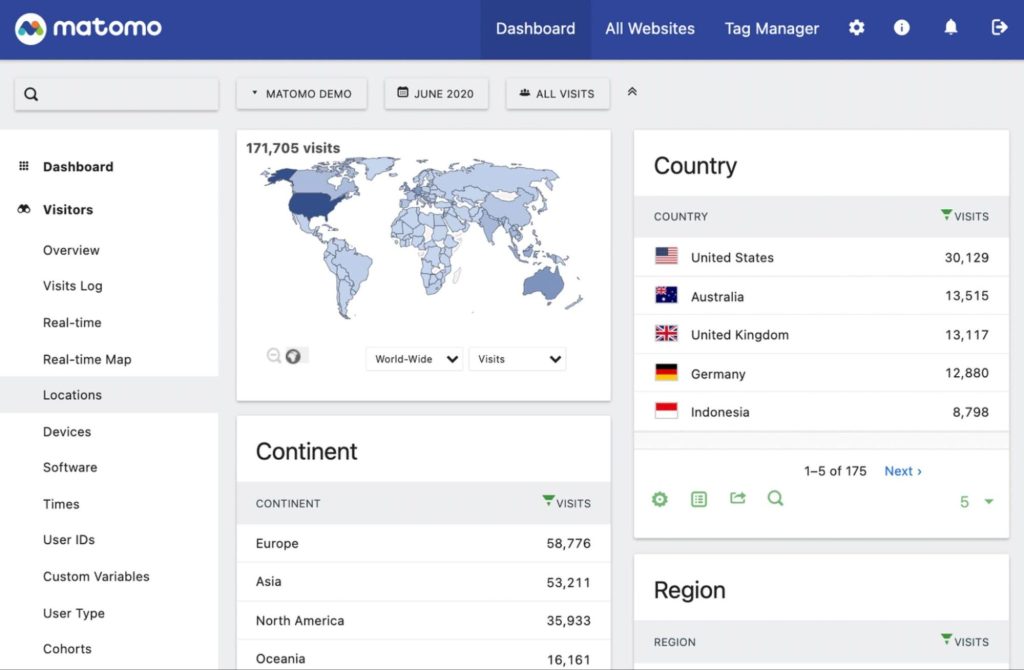Content marketing is an effective strategy for growth and building trust. This is especially true in the fintech industry, where competition is intense and trust is crucial. Content marketing helps you strengthen customer relationships, engage your audience, and differentiate yourself from competitors.
To get the most out of your fintech content marketing, you need to develop the right strategy.
In this guide, we’ll cover everything you need to know about content marketing for fintech companies so you can expand your reach and grow your business.
What is fintech content marketing?
Fintech content marketing is creating content around financial topics on the internet to attract, engage, and convert audiences.
Fintech companies can use a content strategy to drive leads by creating educational content.

While financial content is important, it’s easy for it to feel boring, unrelatable, or confusing. But, when done right, fintech companies can educate their audiences with great content marketing that helps their audience understand financial topics in-depth.
Fintech companies can create written, audio, or video content to inform their audiences about financial topics they’re interested in.
From there, each piece of content can then be distributed to different mediums:
- Blogs
- Website
- YouTube
- Other websites
- Apps
- And more
Once content is distributed, fintech companies can then analyse how effective the content is by tracking web analytics data like search engine traffic, social media engagement, and new customers.
7 reasons fintech companies need content marketing
Before we dive into fintech content marketing best practices, let’s recap why fintech companies need to lean into content to grow their business.
Here are seven reasons your financial company needs to deploy a robust content strategy:

1. Reach new audiences
If you want to grow your fintech company, you need to find new customers. Creating content is a proven path to marketing yourself online and attracting a larger audience.
By using search engine optimisation (SEO), social media marketing, and YouTube, you can expand your audience and grow your customer base.
With content marketing, you can find new audiences without needing a massive budget, making scaling easier.
2. Engage current audience
While content can be a powerful method to reach new customers, it isn’t the only thing it’s good for.
If you want to grow your business, another way to leverage your content is to keep your current audience engaged.
You can create financial content to educate, inform, and add value to your current audience who already knows you. Repurposing content between the different platforms your audience is on keeps them engaged with you and your brand.
It’s a simple way to capture and keep the attention of your audience, build trust, and convert more prospects into customers.
3. Build relationships with customers
You should leverage content marketing in various spaces, such as social media, your website, a blog, or even YouTube. Creating content on different channels allows you to build relationships with your customers on autopilot.
The general rule in marketing is that the more touch points you have with your customers, the more you’ll sell. Creating more content means you always have new opportunities to increase those touchpoints, build deeper relationships, and sell more.
4. Grow authority in a space
If you want people to trust you and your financial tech, you need to be seen as an authority. How can someone trust that your app or web platform will help them with their finances if they don’t trust you’re a financial expert?
You should use informative content to become a thought leader in your space. You can post content on social media or your own platforms.
You can also spread your authority by leveraging other brands’ or influencers’ audiences through guest blog posting and guest podcasting.
5. Drive new leads
Content marketing isn’t just a fun hobby for businesses. It’s one of the smartest ways to drive new leads.
You should be crafting content for your top-of-funnel marketing strategy to attract potential customers.
Creating content consistently is a great way to bring in new audience members into your funnel.
Once you grow your top-of-funnel audience, you can convert them into leads by getting them to join your email list or trial your financial software.
One tip to get more out of your content strategy is creating evergreen content to continually drive leads. For example, create “set-it-and-forget it” blog posts or YouTube videos that will continue working for you daily to attract new audience members searching for helpful financial information. Then, provide a call to action on that content to join your email list (by leveraging a lead magnet).
6. Convert prospects to customers
When you have a continual flow of new top-of-funnel prospects, you always have a fresh cycle of prospects you can convert into customers.
Content is primarily used to attract new audience members and engage your current audience at the top of your funnel. But it can also be used to convert your audience into customers.
Try mixing up your content types to drive conversions:
- Educational
- Entertaining
- Promotional
Don’t just show off educational content.
You should also mix in “authority” content by displaying case studies of user success stories and calling to action to sign up for a free trial or request a demo.
7. Lower Customer Acquisition Cost (CAC)
On the business side, if you want a marketing strategy that will keep expenses low long term, you’ll want to invest more in content.
Content marketing has a great return on investment (ROI) for your time and effort.
Why?
Because the customer acquisition costs (CAC) are so low.
You can create content that can bring in leads for months if not years.
If you only use Google or Facebook ads to drive new leads, you always have to “pay-to-play.” When you turn the advertising tap off, your leads dry up.
But, with blogs and videos, you can create content that can bring in organic customers on repeat. It’s like a snowball effect that keeps going long after you’ve completed the initial work.
10 fintech content marketing best practices
Here are ten best practices to establish a strong content marketing strategy as a fintech company:

1. Set SMART goals
A good content strategy starts with goal-setting. You’ll never get there if you don’t know where you’re going.
To make sure your fintech content marketing strategy is a success, you need to set SMART goals:
- Specific
- Measurable
- Achievable
- Relevant
- Time-bound
For example, you might set a goal to reach 20,000 blog visits in one year and convert blog visits at a rate of 3%.
Setting clear content goals will streamline operations, so you stay consistent and get the most out of your efforts.
3. Be transparent
Transparency is crucial for fintech companies, as they handle sensitive financial data and, in many cases, monetary transactions.
It’s essential for you to be open and clear about your products, services, and data practices. By being honest about privacy and security measures, fintechs can build and maintain trust with their customers.
This transparency not only helps in establishing credibility but also ensures customers feel confident about how their financial information is managed and protected.

4. Take an education-first approach
Content isn’t just about “hooking” or entertaining your audience. That’s just one aspect of a content strategy.
The best approach to building authority and converting leads from your content is to take an education-first approach.
Remember above, when we touched on understanding your ICP? You need to know your ICP’s interests and pain points inside and out and then map your product’s strengths to those that are relevant.
Always start with your ICP, then build the content strategy around them based on your product.
Find connections and identify how your product can address the ICP’s interests and pain points.
For example, let’s say your ICPs are Gen Z consumers. They’re interested in independence and saving for future goals. Their pain points might include lack of investment knowledge and managing student debts and other loans.
Let’s say your product is a personal finance app. Some of your benefits might be budget tracking and beginner-friendly investment options. You could create a content strategy around budgeting in your 20s and investing for beginners.
Content strategies will vary widely based on your ICP. For instance, content for a fintech company targeting those approaching retirement will need a different focus compared to that aimed at younger consumers.
Remember: practical, step-by-step, value-driven content performs best regarding conversions.
5. Leverage the right tools
If you’re going to succeed with content, you need to lean on the right tools.
Here are a few types of tools you should consider (and recommendations):
Try Matomo for Free
Get the web insights you need, without compromising data accuracy.
6. Promote your content on different platforms
You’ll want to promote your fintech content marketing strategy on different channels and platforms to get the most out of your fintech content marketing strategy.
Start with one core platform before you pick a few platforms to promote your content. You should leverage at least one social media platform.
Then, create a blog and an email newsletter to ensure you create multiple touchpoints.
Here are some tips on how to pick the right platform:
- Consider age range (i.e. TikTok for a younger audience, Facebook for an older audience)
- Consider your preferred content type (YouTube for long-form video, X for short-form written content
- Consider your competition (i.e. go where competitive fintech companies already are)
7. Track results
How do you know if you’re on pace to reach the SMART goals you set earlier?
By tracking your results.
You should dive into your data regularly to ensure your content is working. Make sure to track social media, email marketing, and web results.
Keep a close eye on your website KPIs and track your conversions to ensure a return on investment (ROI). For more detailed guidance on monitoring your website’s performance, check out our blog on how to check website traffic as accurately as possible.
Remember, a data-driven approach is the best way to stay on track with your content goals.
8. Establish a content leader
Your content marketing needs a leader. You should establish someone on your marketing team to oversee your content plan.
They should ensure they collaborate well with different teams, understand social media and SEO, and know how to manage projects.
Most of all, don’t forget that they’re in charge of tracking your data and reporting to higher-ups, so they should be comfortable with web analytics and know how to track performance well.
9. Optimise for SEO
It’s not enough to create a weekly blog post. You could craft the most valuable content on your website, but nobody will find it online if it isn’t optimised for SEO.
Your content leader should analyse SEO data using a tool like Ahrefs or SEMrush to analyse different keywords to target in your content.
A web analytics tool like Matomo can then be used to track results. Matomo offers traditional web analytics, including pageviews, bounce rate, and sources of traffic, alongside features like heatmaps, session recordings, and A/B testing.
These advanced features provide deeper insights into how users interact with your site and content, helping you pinpoint areas for improvement. Improving the user experience based on these insights can then positively impact your Google rankings.
Try Matomo for Free
Get the web insights you need, without compromising data accuracy.
10. Stay compliant
Fintech is a highly regulated industry. Keeping this in mind, you need to ensure you take the necessary steps to ensure you remain compliant with all applicable laws and regulations.
Non-compliance can result in severe penalties.
Given these high standards, it’s crucial to ensure that user data remains private and secure. Matomo helps with this by providing a compliant web analytics solution that respects user privacy. With Matomo, you can confidently manage compliance and build trust with your customers while also reliably tracking the performance of your content marketing.

Drive your content marketing strategy with Matomo
Leaning into content marketing can be one of the best ways your fintech company can attract, engage, convert, and retain your audience.
By creating high-quality content for your audience on social media, YouTube, and your website, you can establish your brand as an authority to grow your business for years to come.
But remember, you need to make sure you’re only using privacy-friendly, compliant tools to protect your audience’s data.
Thankfully, Matomo has you covered.
As a privacy-friendly web analytics tool, Matomo ensures that your website data is tracked and stored in compliance with privacy laws.
Trusted by over 1 million websites, it offers reliable data without sampling, guaranteeing accuracy. Matomo is designed to be fully compliant with privacy regulations such as GDPR and CCPA, while also providing advanced features like heatmaps, session recordings, and A/B testing to help you track and enhance your website’s performance.
Request a demo to see how Matomo can benefit your fintech business now.
.cloudsubform {
font-size: 13px;
}
.matomo_signup-elementor-widget .text-center {
text-align: center;
}
.cloudsubform label {
font-weight: bold;
}
.cloudsubform input {
width: 100%;
}
.cloudsubform .list-unstyled {
list-style:none;
margin-left: 0;
}
input.form-control {
border-color: #e7e7e7;
background: #fff;
}
.has-error .checkbox, .has-error .checkbox-inline, .has-error .control-label, .has-error .help-block, .has-error .radio, .has-error .radio-inline, .has-error.checkbox label, .has-error.checkbox-inline label, .has-error.radio label, .has-error.radio-inline label {
color: #a94442;
}
.has-error .form-control {
border-color: #a94442;
}
.form-group.has-error:focus-within .with-errors {
display: none;
}
.input-group {
position: relative;
display: table;
border-collapse: separate;
}
.input-group .form-control:first-child, .input-group-addon:first-child, .input-group-btn:first-child>.btn, .input-group-btn:first-child>.btn-group>.btn, .input-group-btn:first-child>.dropdown-toggle, .input-group-btn:last-child>.btn-group:not(:last-child)>.btn, .input-group-btn:last-child>.btn:not(:last-child):not(.dropdown-toggle) {
border-top-right-radius: 0;
border-bottom-right-radius: 0;
}
.input-group .form-control, .input-group-addon, .input-group-btn {
display: table-cell;
}
.input-group .form-control {
position: relative;
z-index: 2;
float: left;
width: 100%;
margin-bottom: 0;
}
.input-group-addon:last-child {
border-left: 0;
}
.input-group .form-control:last-child, .input-group-addon:last-child, .input-group-btn:first-child>.btn-group:not(:first-child)>.btn, .input-group-btn:first-child>.btn:not(:first-child), .input-group-btn:last-child>.btn, .input-group-btn:last-child>.btn-group>.btn, .input-group-btn:last-child>.dropdown-toggle {
border-top-left-radius: 0;
border-bottom-left-radius: 0;
}
.input-group-addon {
padding: 6px 12px;
font-size: 14px;
font-weight: 400;
line-height: 1;
color: #333;
text-align: center;
background-color: #f2f2f2;
border: 1px solid #e7e7e7;
border-radius: 4px;
}
.input-group-addon, .input-group-btn {
width: 1%;
white-space: nowrap;
vertical-align: middle;
}
.input-group .form-control, .input-group-addon, .input-group-btn {
display: table-cell;
}
.startTrialButton {
background: #299903;
}
.startTrialButton:hover {
background: #16bb0f;
}
.privacyNotice,
header.page-header .entry-summary {
color: #47525f;
margin-top: 15px;
}
header.page-header .page-title {
margin-bottom: 15px;
}
header.page-header {
margin-top: 20px;
margin-bottom: 20px;
}
h2.page-title {
font-size: 30px;
}
input::placeholder {
color: #aeaeae;
}
#signup_form input {
color: #333;
}
.privacyNotice, header.page-header .entry-summary, .form-group label, input {
font-family: Nunito, Arial, sans-serif;
}
.form-group label {
font-size: 14px;
cursor: pointer;
}
.form-group label.checkboxLabel {
font-weight: normal;
}
#signup_form .alert-danger,
.form-group .alert-danger {
color: #a94442;
}
.privacyNotice {
color: #818181;
font-size: 14px;
}
.cloudsubform input[disabled] {
background: #e7e7e7 !important;
}
Try Matomo for Free
21 day free trial. No credit card required.
